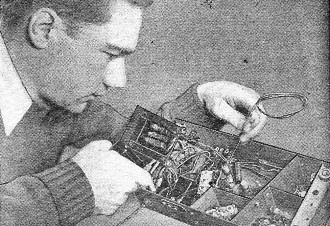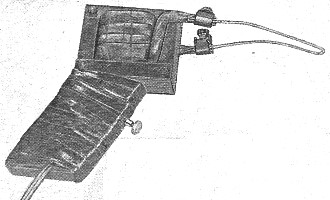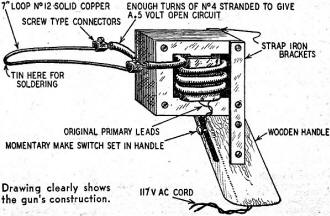A Soldering Gun
|
|
We take a lot for granted these days with the seemingly unlimited availability of cheap stuff of all kinds - some of it complete junk and other of it pretty darn good. That goes for electronics components and complete products and test equipment, tools, automobiles, appliances, and utensils, clothing, medical equipment - you name it. Something as simple as a pistol-type soldering gun can be purchased at just about any hardware or home store, and at a price that when adjusted back to equivalent money in the 1940s would be amazingly cheap even then. For instance a Weller Soldering Gun kit from Lowes sells for $39.48 today (less when on sale), which would have been $3.44 (per the BLS Inflation Calculator) in 1947 when this article showing how to build your own appeared in Radio-Craft magazine. If a soldering gun could have been purchased for a mere $3.44 in 1947, there would have been no need to publish such an article because its cheapness would have obviated any perceived need to build one from scrap parts that might have cost about the same. A Soldering Gun
The author services a receiver with the aid of this soldering gun. By Ral Collins The quick-heating soldering pistols now on the market are desired by many hams and radio experimenters, but the cost is too high to warrant the purchase of one by persons who do not use an iron a great deal. These are such handy little gadgets that I undertook the construction of one from parts out of the ever-present junk box. The first one I constructed is still giving good service after many hours of operation. Any small power transformer having a good primary will furnish the basic element for this gun. The case is unbolted and the laminations carefully disassembled. All windings except the primary are removed (the best way to remove the high-voltage winding is to saw through it with a hacksaw). The number of turns in the 5-volt rectifier winding is counted during the unwinding. This will serve as a guide to the number of turns required by the new high current winding, which will be approximately one-tenth of the number counted, for the new winding is to deliver about 0.5 volt to an open circuit. A little experimenting with more or fewer turns might be necessary to arrive at this potential.
Appearance of the gun. Several modifications might be made to suit it to the taste of the raw materials. When the primary winding is free, the determined number of turns of No.4 stranded synthetic covered wire is bent around it, secured, and the transformer structure is reassembled as shown in the diagram. If sufficient space is not available in the core structure to accommodate the covered No.4, the insulation is removed, and a single layer of friction-tape insulation substituted. A handle with a convenient switch is attached with 2 strap-iron or brass brackets, and the primary connected to a line-cord through the switch and brought out through the bottom of the handle. A 7-inch piece of No. 12 solid bare copper wire is bent in a V and connected to the high-current leads with 2 screw-type connectors to provide a simple and quick means of changing tips. Dip the point of the V in soldering paste, push the switch, and in less than 10 seconds the point can be tinned and ready for work. The tool constructed in this way is not intended for assembly-line use, but will in all probability serve to great advantage in the home workshop.
Posted May 4, 2020 |
|



